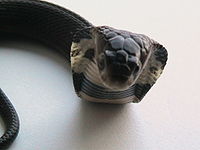- Naja atra
-
Chinese cobra 
Scientific classification Kingdom: Animalia Phylum: Chordata Class: Reptilia Order: Squamata Suborder: Serpentes Family: Elapidae Genus: Naja Species: N. atra Binomial name Naja atra
Cantor, 1842Synonyms Naja nigra Gray
The Chinese cobra (Naja atra, also known as Taiwanese cobra, is a species of genus Naja found mostly in southern China and Taiwan.[1][2][3] Theodore Edward Cantor first described the iridescent black monocled cobra from Chusan Island in 1842.[4] It is one of the most prevalent venomous snakes in Taiwan, which has caused many snakebite incidents to humans.
Contents
Characteristics
This medium-sized snake, usually 1.2–1.5 metres (3.9–4.9 ft) long, reaches a maximum length of 1.94 metres (6.4 ft) (male) and 1.64 metres (5.4 ft) (female). Large specimens of 2.3 metres (7.5 ft) in length have been reported.[1] The dorsal color of the Chinese Cobra is usually brown, grey or black,[2] with or without narrow, light transverse lines at irregular intervals which are especially prominent in juveniles.[1] The hood mark shape of the snake is highly variable: spectacle, mask, horseshoe or O-shape;[2][3] sometimes linking to light throat area. It has clearly defined throat area usually with a black transverse band and 2 black spots above the band.[3]
Scalation
23-29 scale rows around hood (usually 25-27); 19-21 just ahead mid-body (usually 21); ventral scales 161-180 (usually 171 in males, 173 in females); subcaudal scales 37-51 pairs (usually 48 in males, 46 in females).[1][2][3]
Identification
The Chinese cobra is easily confused with the Monocled Cobra (Naja kaouthia). But it is most easily distinguished by virtue of having lower ventral and subcaudal scale counts, particular when sex is taken into account.[2]
Distribution
This species is found in Taiwan, southeastern China (including Hainan), Hong Kong, northern Laos, and northern Vietnam.[1][2][3] Its typical habitat is woodlands, shrublands, grasslands, and mangroves. It usually hides under leaves, sticks, and rocks.[3]
Behavior
The Chinese cobra has a characteristic defensive behavior. When threatened, this snake raises one third of the forebody, hissing loudly, and the characteristic hood on the neck is expanded. The snake may also occasionally spit venom. The Chinese cobra usually escapes to avoid confrontation with humans, but strikes readily if provoked. The Chinese Cobra mainly preys on rodents, frogs, toads and other snakes. It is active during both the day and night.[1][3]
Reproduction
It is oviparous.[3]
Venom
The Chinese cobra's venom consists mainly of cobratoxins (a type of neurotoxins), hemotoxins and cardiotoxins.[5] The LD50 values of its venom in mice are 0.29 mg/kg SC, 0.345 mg/kg IV[6][7] and 0.53 mg/kg IC.[1] The average venom yield from this snake is about 250.8 mg.[1] Some individuals (mostly the specimens from Guizhou Province) might spit venom towards the enemy with a distance of 2 metres (6.6 ft).[1][3]
Local symptoms in victims caused by Chinese cobra are wound darkening, localized redness and swelling, pain, insensibility, and invariably blisters and necrosis. Necrosis is a serious problem in cases of cobra bite as it may persist for many years after the general recovery of the victim. The following systemic symptoms may also occur: chest discomfort, fever, sore throat, difficulty in swallowing, loss of voice, weak feeling in limbs, walking haltingly, general ache, lockjaw, and difficulty in breathing. Fatality occasionally occurs.[1] The anti-venom is widely available and deaths are much rarer than they used to be.
Reference
- ^ a b c d e f g h i j Snakes of medical importance. Singapore: Venom and toxic research group. ISBN 9971622173.
- ^ a b c d e f "Asiatic Naja". http://www.bangor.ac.uk/~bss166/Taxa/AsNaja.htm.
- ^ a b c d e f g h i Venomous Land Snakes, Dr.Willott. Cosmos Books Ltd. ISBN 9882113265.
- ^ Cantor, T. (1842) General Features of Chusan, with remarks on the Flora and Fauna of that Island. Annals and Magazine of Natural History including Zoology, Botany, and Geology. Vol. IX: 482.
- ^ "Studies of the venom of the Taiwan Cobra". http://www.jbc.org/content/256/17/9279.full.pdf.
- ^ "LD50". http://www.seanthomas.net/oldsite/ld50tot.html.
- ^ "LD50 menu". http://www.kingsnake.com/toxinology/LD50/LD50men.html.
Categories:
Wikimedia Foundation. 2010.
